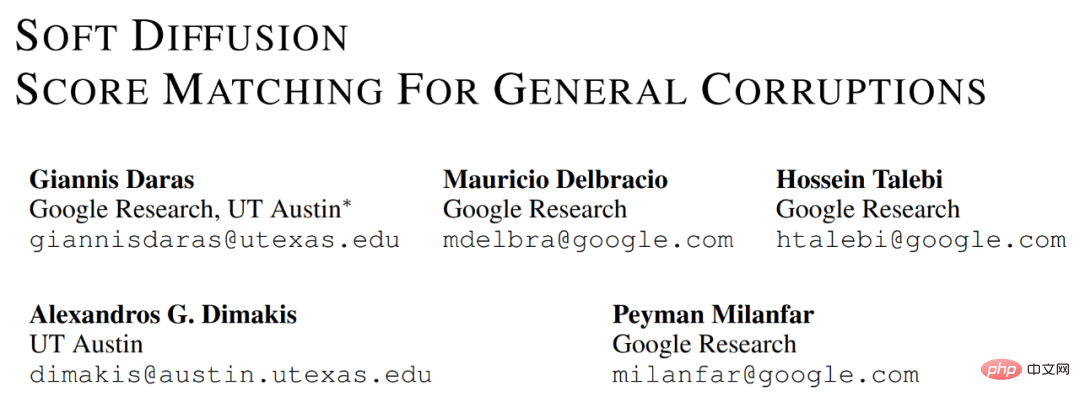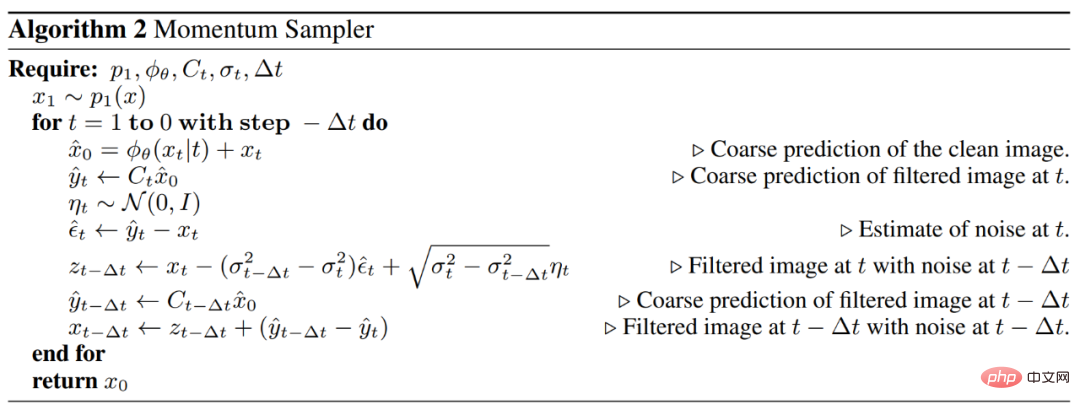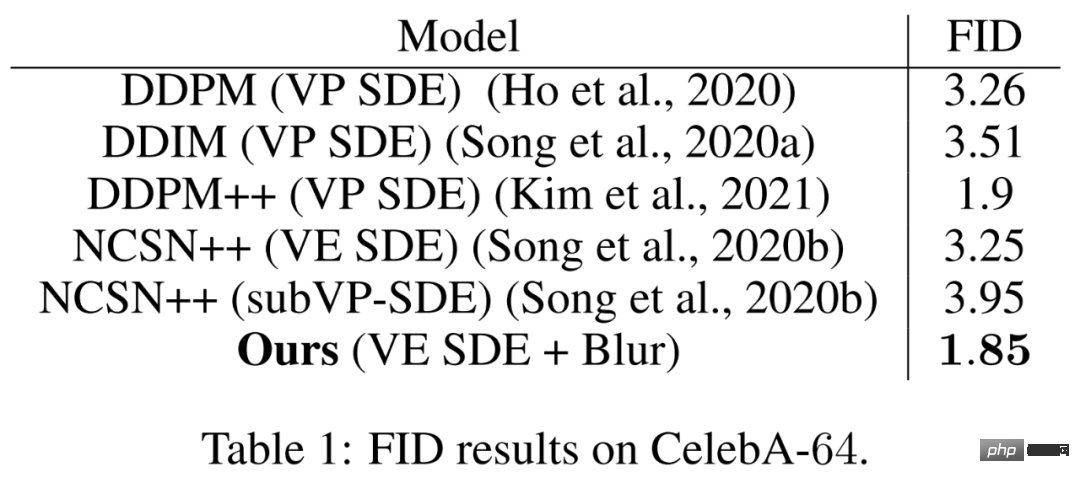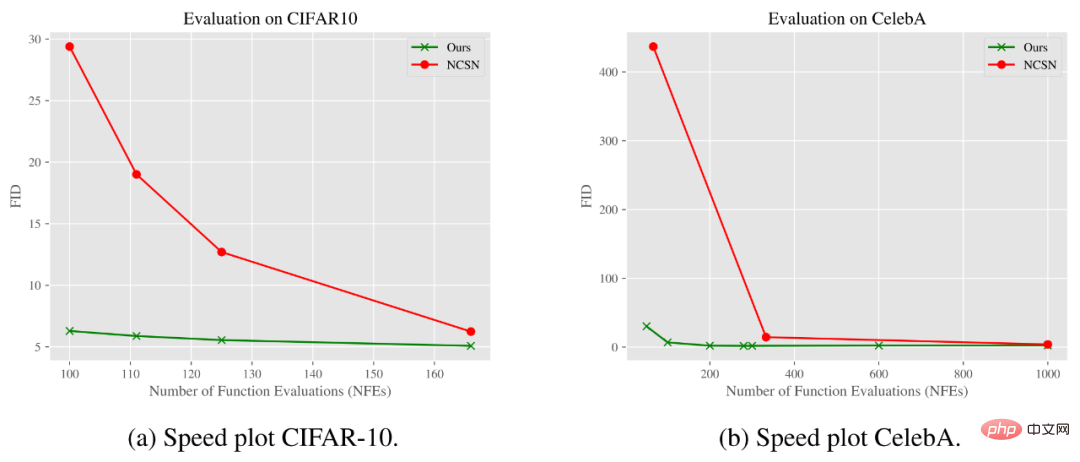 Technology peripherals
Technology peripherals
 AI
AI
 Soft Diffusion: Google's new framework correctly schedules, learns and samples from a universal diffusion process
Soft Diffusion: Google's new framework correctly schedules, learns and samples from a universal diffusion process
Soft Diffusion: Google's new framework correctly schedules, learns and samples from a universal diffusion process
We know that score-based models and denoising diffusion probability models (DDPM) are two powerful types of generative models that generate samples by inverting the diffusion process. These two types of models have been unified into a single framework in the paper "Score-based generative modeling through stochastic differential equations" by Yang Song and other researchers, and are widely known as diffusion models.
At present, the diffusion model has achieved great success in a series of applications including image, audio, video generation and solving inverse problems. In the paper "Elucidating the design space of diffusionbased generative models", researchers such as Tero Karras analyzed the design space of the diffusion model and identified three stages, namely i) selecting the scheduling of the noise level, ii) selecting the network parameters. ization (each parameterization generates a different loss function), iii) design the sampling algorithm.
Recently, in an arXiv paper "Soft Diffusion: Score Matching for General Corruptions" jointly conducted by Google Research and UT-Austin, several researchers believe that the diffusion model still has a Important step: corruption. Generally speaking, corruption is a process of adding noise of different amplitudes, and for DDMP also requires rescaling. Although there have been attempts to use different distributions for diffusion, a general framework is still lacking. Therefore, the researchers proposed a diffusion model design framework for a more general damage process.
Specifically, they proposed a new training objective called Soft Score Matching and a novel sampling method, Momentum Sampler. Theoretical results show that for damage processes that satisfy regularity conditions, Soft Score MatchIng is able to learn their scores (i.e., likelihood gradients) that diffusion must transform any image into any image with non-zero likelihood.
In the experimental part, the researchers trained the model on CelebA and CIFAR-10. The model trained on CelebA achieved the SOTA FID score of the linear diffusion model - 1.85. At the same time, the model trained by the researchers is significantly faster than the model trained using the original Gaussian denoising diffusion.

##Paper address: https://arxiv.org/pdf/2209.05442.pdf
Method OverviewGenerally speaking, diffusion models generate images by inverting a damage process that gradually increases noise. The researchers show how to learn to invert diffusion involving linear deterministic degradation and stochastic additive noise.

#Specifically, the researchers demonstrated a framework for using a more general damage model to train a diffusion model, which consists of three parts, each for new training objectives. Soft Score Matching, novel sampling method Momentum Sampler, and scheduling of damage mechanisms.
Let’s first look at the training target Soft Score Matching. The name is inspired by soft filtering, which is a photography term that refers to a filter that removes fine details. It learns the fraction of a conventional linear damage process in a provable way, also incorporates a filtering process into the network, and trains the model to predict images after damage that match diffusion observations.
This training objective can prove that the score is learned as long as diffusion assigns non-zero probability to any clean, corrupted image pair. Additionally, this condition is always satisfied when additive noise is present in the damage.
Specifically, the researchers explored the damage process in the following form.

In the process, the researchers discovered that noise has both empirical (i.e., better results) and theoretical (i.e., for learning fractions) benefits. Very important. This also becomes a key difference from Cold Diffusion, a concurrent work that reverses deterministic corruption.
The second is the sampling method Momentum Sampling. The researchers demonstrated that the choice of sampler has a significant impact on the quality of the generated samples. They proposed Momentum Sampler for inverting a universal linear damage process. The sampler uses convex combinations of damage with different diffusion levels and is inspired by momentum methods in optimization.
This sampling method is inspired by the continuous formulation of the diffusion model proposed in the paper by Yang Song et al. above. The algorithm for Momentum Sampler is shown below.

The following figure visually shows the impact of different sampling methods on the quality of the generated samples. The image sampled with Naive Sampler on the left seems repetitive and lacks detail, while the Momentum Sampler on the right significantly improves the sampling quality and FID score.

The last thing is scheduling. Even if the type of degradation is predefined (like blurring), deciding how much to damage at each diffusion step is not trivial. The researchers propose a principled tool to guide the design of damage processes. To find the schedule, they minimize the Wasserstein distance between distributions along the path. Intuitively, researchers want a smooth transition from a completely corrupted distribution to a clean distribution.
Experimental Results
The researchers evaluated the proposed method on CelebA-64 and CIFAR-10, both of which are standard baselines for image generation. The main purpose of the experiment is to understand the role of damage type.
The researchers first tried to use blur and low-amplitude noise for damage. The results show that their proposed model achieves SOTA results on CelebA, i.e., an FID score of 1.85, outperforming all other methods that only add noise and possibly rescale the image. In addition, the FID score obtained on CIFAR-10 is 4.64, which is competitive even though it does not reach SOTA.

In addition, on the CIFAR-10 and CelebA data sets, the researcher's method also performed better on another indicator, sampling time. Another added benefit is significant computational advantages. Deblurring (almost no noise) appears to be a more efficient manipulation compared to image generation denoising methods.
The graph below shows how the FID score changes with the Number of Function Evaluations (NFE). As can be seen from the results, our model can achieve the same or better quality than the standard Gaussian denoising diffusion model using significantly fewer steps on the CIFAR-10 and CelebA datasets.

The above is the detailed content of Soft Diffusion: Google's new framework correctly schedules, learns and samples from a universal diffusion process. For more information, please follow other related articles on the PHP Chinese website!

Hot AI Tools

Undresser.AI Undress
AI-powered app for creating realistic nude photos

AI Clothes Remover
Online AI tool for removing clothes from photos.

Undress AI Tool
Undress images for free

Clothoff.io
AI clothes remover

Video Face Swap
Swap faces in any video effortlessly with our completely free AI face swap tool!

Hot Article

Hot Tools

Notepad++7.3.1
Easy-to-use and free code editor

SublimeText3 Chinese version
Chinese version, very easy to use

Zend Studio 13.0.1
Powerful PHP integrated development environment

Dreamweaver CS6
Visual web development tools

SublimeText3 Mac version
God-level code editing software (SublimeText3)

Hot Topics
 1655
1655
 14
14
 1413
1413
 52
52
 1306
1306
 25
25
 1252
1252
 29
29
 1226
1226
 24
24
 How much is Bitcoin worth
Apr 28, 2025 pm 07:42 PM
How much is Bitcoin worth
Apr 28, 2025 pm 07:42 PM
Bitcoin’s price ranges from $20,000 to $30,000. 1. Bitcoin’s price has fluctuated dramatically since 2009, reaching nearly $20,000 in 2017 and nearly $60,000 in 2021. 2. Prices are affected by factors such as market demand, supply, and macroeconomic environment. 3. Get real-time prices through exchanges, mobile apps and websites. 4. Bitcoin price is highly volatile, driven by market sentiment and external factors. 5. It has a certain relationship with traditional financial markets and is affected by global stock markets, the strength of the US dollar, etc. 6. The long-term trend is bullish, but risks need to be assessed with caution.
 Recommended reliable digital currency trading platforms. Top 10 digital currency exchanges in the world. 2025
Apr 28, 2025 pm 04:30 PM
Recommended reliable digital currency trading platforms. Top 10 digital currency exchanges in the world. 2025
Apr 28, 2025 pm 04:30 PM
Recommended reliable digital currency trading platforms: 1. OKX, 2. Binance, 3. Coinbase, 4. Kraken, 5. Huobi, 6. KuCoin, 7. Bitfinex, 8. Gemini, 9. Bitstamp, 10. Poloniex, these platforms are known for their security, user experience and diverse functions, suitable for users at different levels of digital currency transactions
 What are the top ten virtual currency trading apps? The latest digital currency exchange rankings
Apr 28, 2025 pm 08:03 PM
What are the top ten virtual currency trading apps? The latest digital currency exchange rankings
Apr 28, 2025 pm 08:03 PM
The top ten digital currency exchanges such as Binance, OKX, gate.io have improved their systems, efficient diversified transactions and strict security measures.
 Which of the top ten currency trading platforms in the world are the latest version of the top ten currency trading platforms
Apr 28, 2025 pm 08:09 PM
Which of the top ten currency trading platforms in the world are the latest version of the top ten currency trading platforms
Apr 28, 2025 pm 08:09 PM
The top ten cryptocurrency trading platforms in the world include Binance, OKX, Gate.io, Coinbase, Kraken, Huobi Global, Bitfinex, Bittrex, KuCoin and Poloniex, all of which provide a variety of trading methods and powerful security measures.
 Decryption Gate.io Strategy Upgrade: How to Redefine Crypto Asset Management in MeMebox 2.0?
Apr 28, 2025 pm 03:33 PM
Decryption Gate.io Strategy Upgrade: How to Redefine Crypto Asset Management in MeMebox 2.0?
Apr 28, 2025 pm 03:33 PM
MeMebox 2.0 redefines crypto asset management through innovative architecture and performance breakthroughs. 1) It solves three major pain points: asset silos, income decay and paradox of security and convenience. 2) Through intelligent asset hubs, dynamic risk management and return enhancement engines, cross-chain transfer speed, average yield rate and security incident response speed are improved. 3) Provide users with asset visualization, policy automation and governance integration, realizing user value reconstruction. 4) Through ecological collaboration and compliance innovation, the overall effectiveness of the platform has been enhanced. 5) In the future, smart contract insurance pools, forecast market integration and AI-driven asset allocation will be launched to continue to lead the development of the industry.
 Which of the top ten currency trading platforms in the world are among the top ten currency trading platforms in 2025
Apr 28, 2025 pm 08:12 PM
Which of the top ten currency trading platforms in the world are among the top ten currency trading platforms in 2025
Apr 28, 2025 pm 08:12 PM
The top ten cryptocurrency exchanges in the world in 2025 include Binance, OKX, Gate.io, Coinbase, Kraken, Huobi, Bitfinex, KuCoin, Bittrex and Poloniex, all of which are known for their high trading volume and security.
 What are the top currency trading platforms? The top 10 latest virtual currency exchanges
Apr 28, 2025 pm 08:06 PM
What are the top currency trading platforms? The top 10 latest virtual currency exchanges
Apr 28, 2025 pm 08:06 PM
Currently ranked among the top ten virtual currency exchanges: 1. Binance, 2. OKX, 3. Gate.io, 4. Coin library, 5. Siren, 6. Huobi Global Station, 7. Bybit, 8. Kucoin, 9. Bitcoin, 10. bit stamp.
 How to use the chrono library in C?
Apr 28, 2025 pm 10:18 PM
How to use the chrono library in C?
Apr 28, 2025 pm 10:18 PM
Using the chrono library in C can allow you to control time and time intervals more accurately. Let's explore the charm of this library. C's chrono library is part of the standard library, which provides a modern way to deal with time and time intervals. For programmers who have suffered from time.h and ctime, chrono is undoubtedly a boon. It not only improves the readability and maintainability of the code, but also provides higher accuracy and flexibility. Let's start with the basics. The chrono library mainly includes the following key components: std::chrono::system_clock: represents the system clock, used to obtain the current time. std::chron



